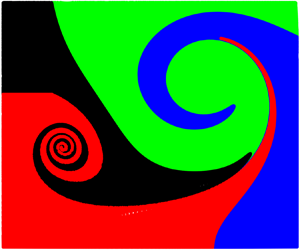No CrossRef data available.
Published online by Cambridge University Press: 21 November 2024

The formation mechanism for the stopping vortex ring (SVR) and its effects on the development of starting jets have been systematically investigated. The radial inward flow near the nozzle exit, arising from the pressure difference caused by the deceleration of starting jets, is considered to be the main contributing factor to the formation of the SVR. The formation process can generally be divided into (i) the rapid accumulation stage ( $t_d^*\leq 1$) and (ii) the development stage (
$t_d^*\leq 1$) and (ii) the development stage ( $t_d^*>1$), where
$t_d^*>1$), where  $t_d^*$ is the formation time defined by the duration of the deceleration stage. For starting jets with different
$t_d^*$ is the formation time defined by the duration of the deceleration stage. For starting jets with different  $(L/D)_d$, the final circulation value and circulation growth rate of the SVR can be scaled by
$(L/D)_d$, the final circulation value and circulation growth rate of the SVR can be scaled by  $[(L/D)_d]^{-0.5}$ and
$[(L/D)_d]^{-0.5}$ and  $[(L/D)_d]^{-1.5}$, respectively. Here
$[(L/D)_d]^{-1.5}$, respectively. Here  $(L/D)_d$ represents the stroke ratio during the deceleration stage. Analysing the temporal evolution of fluid parcels in the vicinity of the nozzle exit reveals that SVR entrains fluid from both inside and outside of the nozzle. Additionally, the influence of the SVR on the leading vortex ring and the trailing jet has been examined, with particular attention to its effects on the propulsive performance of the starting jet. The SVR affects the profiles of axial velocity and gauge pressure at the nozzle exit, thereby enhancing the generation of total thrust during the deceleration stage. Analysis has shown that depending on the deceleration rate, SVR can enhance the average velocity thrust by at least
$(L/D)_d$ represents the stroke ratio during the deceleration stage. Analysing the temporal evolution of fluid parcels in the vicinity of the nozzle exit reveals that SVR entrains fluid from both inside and outside of the nozzle. Additionally, the influence of the SVR on the leading vortex ring and the trailing jet has been examined, with particular attention to its effects on the propulsive performance of the starting jet. The SVR affects the profiles of axial velocity and gauge pressure at the nozzle exit, thereby enhancing the generation of total thrust during the deceleration stage. Analysis has shown that depending on the deceleration rate, SVR can enhance the average velocity thrust by at least  $10\,\%$ and compensate for up to a
$10\,\%$ and compensate for up to a  $60\,\%$ reduction in pressure thrust due to deceleration.
$60\,\%$ reduction in pressure thrust due to deceleration.